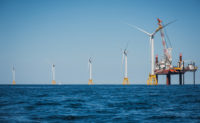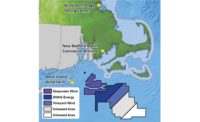Despite the struggles of the now dormant Cape Wind offshore wind project in state waters, Massachusetts officials hope enactment of a law that sets new clean energy targets—including the largest state commitment to offshore wind power in the U.S.—will position the Bay State to compete with programs in neighboring Maine and Rhode Island and drive economic value from the energy source.
The law, signed by Gov. Charlie Baker (R) on Aug. 8, mandates Massachusetts utilities to purchase, by 2027, 1,600 MW of offshore wind power as well as 1,200 MW of hydropower, land-based wind power or solar energy.
He said the law "moves us closer to reaching our aggressive greenhouse gas reduction target" of 25% by 2020 and to "replacing the estimated 10,000 megawatts the region stands to lose” by then, with nuclear and fossil power plant retirements.
David Ismay, senior attorney at the nonprofit Conservation Law Foundation in Boston, says the authorized 1,600-MW offshore wind mandate by 2027, which is enough to power almost 1 million Massachusetts homes, should help jump-start a lasting local industry and deliver wind power for as low as 8 cents per kW/hr, a price that allows clean wind energy to compete head-to-head with fossil-fuel power.
To enhance ratepayer savings associated with procurement of renewable energy, the legislation also authorizes use of energy storage technologies—such a batteries, flywheels, thermal and compressed air—paired with renewable power generation.
Almost simultaneous to the clean energy law, Dong Energy—Denmark’s largest energy developer and a major offshore wind developer in Europe—secured a federal lease 15 miles off the coast of Martha’s Vineyard and submitted an application with regional grid operator ISO-New England for an 800-MW interconnection link of grid capacity at the coal-fired Brayton Point Power Plant in Somerset, Mass., says Lauren Burm, spokeswoman for the developer.
Dong Energy plans to use the critical transmission link for its offshore wind substation for the 1-gigawatt wind farm off Martha’s Vineyard. The 1,488-MW Brayton Point plant is set for retirement next June, one of three large power facilities in the state shutting down over the next few years.
Offshore MW, Princeton, N.J., has also secured a federal lease to develop an offshore wind farm 14 miles south of Martha’s Vineyard. It is partnering with the non-profit Vineyard Power Cooperative to explore opportunities, according to its website.
Unlike the ambitious 468-MW Cape Wind project that has stalled but not halted development activity, the more recent deep water projects will be sited in deeper water farther from the coastline and are not expected to cause the high level of NIMBY (not-in-my-backyard) concern.
The Massachusetts law "is the first legislation of its kind that includes a specific carve-out for offshore wind at a scale necessary to create a viable market in the United States,” Dong Energy said in a statement. “The bill is designed to address the state’s growing energy needs through increased efficiency measures, grid modernization and a dedicated shift to cleaner, renewable sources of energy.”
Thomas Brostrøm, general manager of Dong Energy Wind Power, North America, says that one-third of potential offshore wind resources in the U.S. are located on the East Coast, which has similar site conditions to its offshore wind projects in the UK, Denmark and Germany. “DONG Energy is looking for opportunities up and down the Atlantic coastline, from northeast Maine to the Carolinas," he said. “With world-class wind speeds and ideal water depths of between 130 ft to 165 ft, Massachusetts will be able to garner the economic benefits."
George Bachrach, president of the Environmental League of Massachusetts, told Boston area media that the requirement to procure offshore wind will lead to construction of the first commercially scaled wind farm in the U.S.
Meanwhile, Dong Energy's push for offshore wind in Europe got a boost when UK officials approved on Aug. 17 an expansion of its Hornsea project off the coast of England, which is set to be the world's largest offshore wind power generator and include nearly 600 wind turbines.
The first phase of Hornsea, now underway, is set to generate 1.2 GW of power. The newly approved second phase would generate 1.8 GW, equal to that of two large natural gas or coal plants.
The U.K. aims to have offshore wind deliver 10% of its electricity needs by 2020.
Dong Energy said in a statement that it has already spent almost $7.8 billion in the U.K. working on the project. The company is also partly owned by the Danish government and by investment bank Goldman Sachs.
However, the UK-based Guardian newspaper said Dong Energy has not finalized its investment decision in the second phase,





Post a comment to this article
Report Abusive Comment